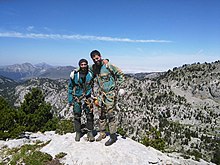Speleology
Speleology (from the Greek σπηλαιου spelaiou meaning cave and -logy, treatise) is the practice of exploring and/or studying the natural cavities in the subsoil. From its Greek roots, speleology was considered as a science that, supported by geology, studies the development, evolution and geological formations of natural cavities (speleothems or speleoliths). In it, all kinds of discoveries in caves are investigated, mapped and cataloged. From the geological point of view, it is part of geomorphology and supports hydrogeology.
Several types of speleology can be distinguished, and it is not necessarily linked to research or study as indicated by its Greek roots. There are various types of Speleology such as tourist tours (Speleotourism), technical-sports speleology, speleorescate (or speleosocorro), scientific speleology, among others. In addition, speleology can also be classified according to the type of cavity in which they develop. Geology with its subdivisions (geomorphology, hydrogeology, etc.) is considered one of the main karst sciences.
Caving offers a multitude of attractions, both recreational and scientific at various levels, which makes it a very complete activity. Speleologists are also involved in the rescue in cavities, called speleosocorro. A sport is often considered, as Noel Llopis Lladó announced in 1954, that authentic caving was in danger, since there was a "confusionism" between sport (caving) and science (caving).
It has been proposed that those occasions in which its practice is rather similar to a sport, it would be more appropriate to call it caving; although, it does not stop having its origins in a science that studies the morphology of the natural cavities of the subsoil. All kinds of underground discoveries are investigated, surveyed and catalogued. What's more, speleology is a science in which several others are involved: the formation and characteristics of cavities are of interest to geographers and geologists; underground watercourses to hydrologists; the fauna (more varied and numerous than is believed) to the biospeleologists; the vestiges of prehistoric man to anthropologists and archaeologists and animal fossils to paleontologists, etc.
Speleology is linked to geology, biology, anthropology, topography, paleoclimatology and others, for this reason it should be considered as an application of various sciences and not as a science per se, In addition, speleology can also be carried out without scientific or academic intentions, such as speleotourism, technical-sports speleology, potholing, among others. For all this, the current definition surpasses the Greek origin that was given to it by "study of caves".
Édouard Alfred Martel is considered the father of modern speleology. He initiated the first scientific explorations and in 1895 founded the Speleological Society of France.
Types of speleology according to the type of cavity in which they develop
Karstic caving
The term Karst comes from the Slovenian word Kras meaning "stony and barren ground", the name of a Slovenian region, called Karst in German.
Since it is practiced in the longest and most uneven caves on the planet, it can be considered the main branch of speleological exploration; Exploration conditions are also generally harsh. Many of the currently known karst caves are found in relatively cold mountain ranges, with permanent underground water currents. These rivers often have frigid temperatures that make progression more difficult for the spelunker, or they can swell suddenly due to storms outside, leaving spelunking teams stranded in dry parts of the cave.
It develops in cavities of karstic origin, that is, cavities excavated by water currents in massifs of soluble rocks such as limestone and dolomite. There are also cavities drilled in gypsum massifs, saline (halite) and even under glaciers (cases called pseudokarst), and which, after all, are caused by a process of dissolution of the host rock. These processes develop very slowly, and it may take millions of years to form a cavity and concretize it (the stalactites, gours, eccentrics... are secondary speleothems that form the so-called cavity decoration).
Caving Diving
Caving is the most complicated and difficult variant of speleology, which focuses its activity on the exploration of underwater cavities. Many of the caves end in conduits clogged by water, called siphons. From this point, the cave divers take over from the cavers to continue exploring the cavity. The practice of diving in caves must be carried out by people who, in addition to being good speleologists and expert divers, master the techniques with specialized equipment. Mixtures with helium, oxygen and nitrogen (Trimix and Nitrox) are sometimes needed to lower long decompression times and combat nitrogen narcosis.
The hostile characteristics of flooded spaces in caves make cave diving one of the most dangerous activities in the world. Although great precautions are taken and security systems are redundant, errors too often claim lives.
Volcanic caving
Vulcanospeleology is the speleology that takes place in volcanic caves, that is, those that are created by the lava of a volcano during an eruption, either by displacements of fluid lava (reogenetic character) or by thermal retraction movements (character tectonic). Most volcanic cavities are formed in a short period of time: days, months, or at most years, depending on the duration of the volcanic eruption.
However, the most common type of volcanic cavities originates from the flow of a volcanic lava flow over moderately sloping terrain (almost horizontal displacement), giving rise to what is known as a volcanic tube or lava tube. These tubes have a low inclination (rarely exceeds 60%), so they can generally be traversed without the need for ropes. The general absence of water, since it does not intervene in the genesis of the cavity, is a point that makes volcano speleology simpler, since risks derived from its presence, such as floods and hypothermia, are eliminated.
But the difficulty comes from other characteristics, such as a generally rough substrate, the existence of many narrow passages and temperatures that tend to be hot (although this depends on the geographical region where the cave is located). Sometimes, it is also necessary to use ropes in the so-called volcanic chasms, which are formed by a vertical displacement of the flowing lava, or in lava cascades inside volcanic tubes.
These exploration characteristics mean that the vulcanocaver's progression gear is generally lighter and less sophisticated than that used by a karst caver.
Beauties of the underground environment
In a cavity the formations are very numerous, and they are known as "decoration" or more specifically speleothems; in karstic caves they can be found from "simple" stalactites and stalagmites to an immensity of varied formations, banners, concretions, gours, eccentrics, microgours, gouge blows, castings, pisolitas, conulitos, columns, many types of helictites, anthodites and other formations typical of each type of cave depending on the place where they are The latter, the eccentric ones, differ from the rest due to their curious shape. It often resembles the shape of a toothpaste created when the tube is pressed hard. Their rarity lies in the fact that instead of being vertical formations they are horizontal. The large congregation of eccentrics hanging from the ceiling are called lamps. In Spain we find in the Cueva de El Soplao (Cantabria) the largest extension of eccentrics and lamps in all of Europe known to date.
Volcanic tubes also have their own decoration, created both by the lava solidifying in various formations (primary or reogenetic decoration) and by subsequent water seepage, once the cavity is consolidated (secondary or epigenetic concretions). Among the primary forms are staphyllites, cornices, terraces, churretes, castles, jameos, lava lakes, lava waterfalls, and columns. Among the concretions, the calcareous ones stand out (which in some tubes form small stalactites) and especially those made of gypsum, since basalt subjected to constant humidity tends to form this mineral.
Contenido relacionado
Earth mantle
Geyser
Galium aparine



